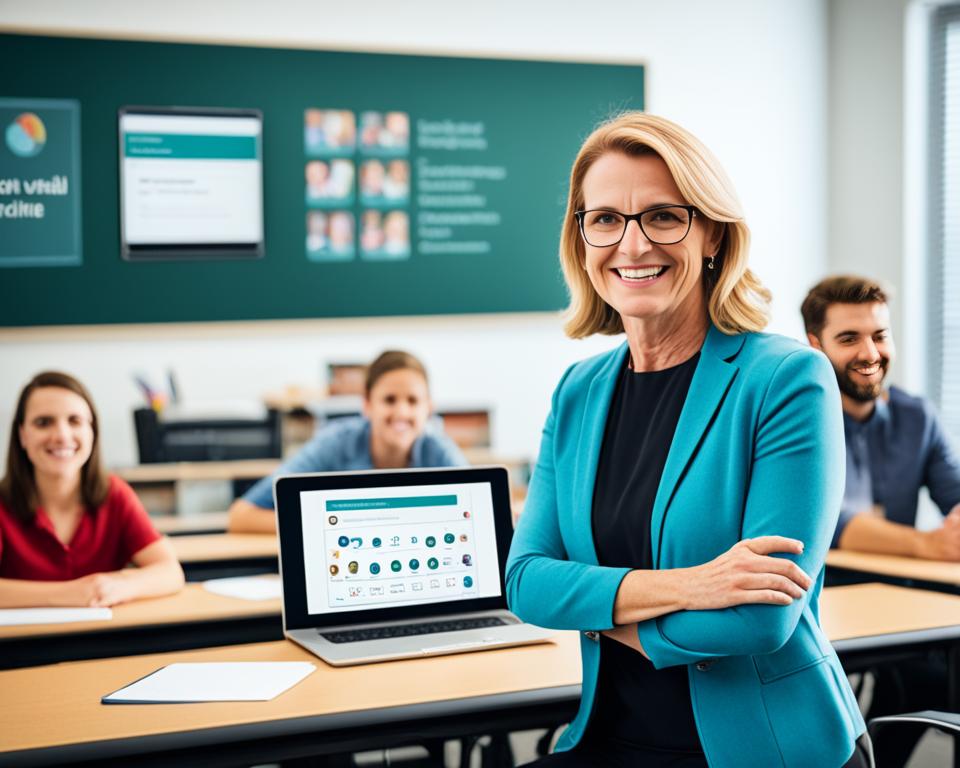Remote learning has become a necessity for many students and educators due to the pandemic, but it also poses significant challenges for academic success. This article will explore comprehensive remote academic support to excel in studies, including online tutoring, virtual learning assistance, and various resources for distance education. With the wide range of virtual study aids and remote educational assistance available, students can receive the help they need to thrive in their learning journey.
Key Takeaways:
- Remote academic support plays a crucial role in promoting successful learning.
- Online tutoring and virtual learning assistance provide students with the necessary tools and guidance.
- Utilizing virtual study aids and remote educational assistance enhances academic success in remote learning environments.
- Accessing diverse resources and support helps students thrive in their learning journey.
- The growth of online education and the availability of remote academic support services contribute to the potential of remote learning.
Establish Clear Goals and Expectations
To achieve academic success in remote learning, it is crucial to establish clear and realistic goals and expectations. Clear communication of these goals and expectations to students, colleagues, and oneself is vital. Providing frequent feedback and ample support along the way helps students stay on track. Students must understand the learning objectives, assessment criteria, and deadlines for each assignment. Setting boundaries and routines for communication, time management, workload management, and work-life balance also contributes to effective remote learning.
Clear Communication of Goals and Expectations
When it comes to remote learning, clear communication is key. Students need to know what is expected of them and what goals they should strive to achieve. Educators must clearly articulate the learning objectives and assessment criteria for each assignment or project. By providing students with a roadmap for success, they can better understand their progress and areas of improvement.
Frequent Feedback and Ample Support
Remote learning can sometimes feel isolating, but consistent feedback and support can make a significant difference. Regular check-ins, one-on-one discussions, and virtual office hours allow educators to provide guidance and address any concerns or questions that students may have. By offering constructive feedback and encouragement, educators can motivate students to reach their full potential.
Understanding Learning Objectives, Assessment Criteria, and Deadlines
Clarity regarding learning objectives, assessment criteria, and deadlines is crucial for students to navigate their academic journey effectively. Students should have a clear understanding of what they need to accomplish and how their work will be evaluated. By aligning their efforts with these expectations, students can focus on meeting the requirements and fulfilling their academic goals.
Setting Boundaries and Routines
Boundaries and routines play a vital role in remote learning. Establishing designated study times, regular breaks, and clear boundaries for communication and work-life balance can help students maintain focus and structure in their learning environment. By defining clear boundaries and routines, students can effectively manage their time, workload, and priorities.
Work-Life Balance
One of the key challenges in remote learning is achieving a healthy work-life balance. Without the physical separation of school and home, it can be challenging for students to switch between study mode and personal time. Setting clear boundaries and routines helps students create a balanced schedule that allows for dedicated study time as well as relaxation and self-care.
| Benefits of Establishing Clear Goals and Expectations |
|---|
| Improved focus and motivation |
| Enhanced clarity and understanding of expectations |
| Increased accountability and responsibility |
| Effective time and workload management |
| Reduced stress and anxiety |
Use a Variety of Tools and Strategies
Remote learning provides educators with the opportunity to explore a wide range of tools and strategies, enhancing the overall learning experience for students. By incorporating a diverse array of resources, educators can create engaging and interactive remote learning environments that promote a sense of community and facilitate personalized learning opportunities.
One of the most effective ways to promote student engagement in remote learning is through the use of video conferencing. This technology allows educators to deliver live lectures, facilitate discussions, and provide real-time feedback, creating a dynamic virtual classroom environment. Additionally, video conferencing helps foster human connection and interaction, mitigating the feelings of isolation often associated with remote learning.
Another valuable tool for remote learning is the use of online quizzes. These quizzes not only provide students with valuable self-assessment opportunities but also offer educators insight into student comprehension and progress. Online quizzes can be easily administered and graded, providing timely feedback and allowing educators to tailor their instruction accordingly.
Podcasts and blogs are effective tools for delivering information in an engaging and accessible manner. These mediums allow students to explore topics at their own pace, promoting active learning and independent thinking. Additionally, podcasts and blogs can be easily shared and accessed, providing students with a wealth of supplemental resources to aid in their learning journey.
Engaging students in discussions is another crucial aspect of remote learning. Discussion boards provide a platform for students to share ideas, ask questions, and engage in meaningful conversations with their peers. These boards foster collaboration and critical thinking, enabling students to broaden their perspectives and develop their communication skills.
Collaborative projects offer students opportunities to work together towards a common goal, promoting teamwork and problem-solving skills. By utilizing collaborative project tools, such as shared documents and project management platforms, students can collaborate seamlessly, regardless of their physical location. These projects not only enhance learning but also encourage a sense of community and camaraderie among students.
Gamification is another effective strategy for remote learning. Incorporating elements of game design, such as points, levels, and badges, into the learning process can increase student motivation and engagement. Gamified learning platforms provide interactive and immersive experiences, making learning enjoyable and fostering a sense of achievement.
Overall, utilizing a variety of tools and strategies creates engaging learning opportunities in remote education. By incorporating video conferencing, online quizzes, podcasts, blogs, discussion boards, collaborative projects, and gamification, educators can provide students with a rich and diverse learning experience. These tools and strategies not only enhance student engagement and participation but also foster a sense of community and belonging in the remote learning environment.
Monitor and Assess Progress and Performance
Monitoring and assessing student progress and performance is an essential aspect of remote academic success. Through various assessment methods, educators can measure learning outcomes, identify strengths and weaknesses, and provide timely feedback to enhance student learning.
Formative and summative assessments play a crucial role in monitoring student progress. Formative assessments, such as quizzes and class discussions, allow educators to gauge student understanding throughout the learning process. Summative assessments, such as exams and projects, provide a comprehensive evaluation of student knowledge and skills at the end of a unit or course.
In addition to formal assessments, self-assessments and peer assessments can empower students to take ownership of their learning. Self-assessments encourage students to reflect on their performance, identify areas for improvement, and set personal goals. Peer assessments promote collaboration and allow students to provide constructive feedback to their classmates.
Measuring learning outcomes goes beyond assigning grades. It involves understanding how well students have achieved the intended learning objectives. By aligning assessments with these objectives, educators can evaluate the effectiveness of their teaching strategies and make necessary adjustments.
Timely feedback is crucial in remote learning environments. It helps students understand their strengths and weaknesses, reinforces learning, and guides future improvement. By providing specific and actionable feedback, educators can foster student growth and development.
Data and analytics tools provide valuable insights into student engagement, attendance, and satisfaction. These tools allow educators to track student performance and identify areas where additional support may be needed. By collecting and analyzing data, educators can make informed decisions to optimize the learning experience.
Table: Types of Assessments
| Assessment Type | Description |
|---|---|
| Formative Assessments | Informal assessments conducted during the learning process to monitor student progress and understanding |
| Summative Assessments | Comprehensive assessments conducted at the end of a unit or course to evaluate student knowledge and skills |
| Self-Assessments | Assessments where students reflect on their performance and set personal learning goals |
| Peer Assessments | Assessments where students provide feedback and evaluate the work of their peers |
Regularly monitoring and assessing student progress and performance ensures that educators have a comprehensive understanding of each student’s learning journey. By identifying strengths and weaknesses, educators can provide targeted support and adjust their teaching strategies to maximize learning outcomes in remote learning environments.
Provide Emotional and Social Support
Remote learning can be challenging and isolating, causing stress and emotional strain for both students and educators. To create a positive and supportive learning environment, it is crucial to provide emotional and social support. By establishing regular check-ins, demonstrating empathy and compassion, and fostering a sense of community, educators can help address the unique challenges that students may face in remote learning.
One effective way to provide emotional support is by acknowledging students’ achievements and challenges. Recognizing their accomplishments, no matter how small, can boost their confidence and motivation. Additionally, by openly acknowledging the difficulties they encounter, educators validate their experiences and show understanding.
Encouraging participation and collaboration is another strategy for supporting students emotionally. Actively engaging students in discussions and group projects enables them to connect with their peers, reducing feelings of isolation. Collaboration fosters a sense of belonging and provides an opportunity for students to support and learn from each other.
Offering resources and referrals is also an essential aspect of providing emotional and social support. Educators should provide access to tools, materials, and support services that can assist students in handling the challenges of remote learning. This can include online counseling services, mental health resources, or academic support programs.
Overall, prioritizing student well-being through emotional and social support is paramount in remote learning environments. By establishing regular check-ins, showing empathy, acknowledging achievements and challenges, encouraging participation, and offering resources and referrals, educators can foster a positive and supportive learning environment that promotes student success and well-being.
Quoting Educator:
“Providing emotional and social support is crucial in remote learning. Regular check-ins and acknowledging students’ achievements and challenges can make a significant difference. Creating a sense of community and offering resources are essential for students’ well-being and academic success.”
– Mike Johnson, Online Educator
Benefits of Emotional and Social Support:
- Reduces feelings of stress and isolation
- Boosts student confidence and motivation
- Fosters a sense of community and belonging
- Encourages collaboration and peer learning
- Provides access to resources and support services
Seek Feedback and Improvement
Academic success in remote learning requires a continuous process of improvement and adaptation. Seeking feedback from students, colleagues, and supervisors is crucial to identify what works well and what needs improvement in the remote learning environment. By actively seeking student feedback, educators can gain valuable insights into the effectiveness of their teaching methods and the overall quality of the remote learning experience.
Colleague feedback also plays a significant role in professional growth. Collaborating with colleagues allows for the exchange of innovative ideas and best practices, leading to continuous improvement in remote teaching strategies. It fosters a supportive community of educators, all working towards enhancing the effectiveness of remote learning.
Supervisor feedback offers guidance and mentorship on professional development. Supervisors can provide valuable insights and recommendations based on their expertise, helping educators refine their remote teaching skills and enhance student engagement.
Reflection is an essential component of seeking feedback and improvement. Taking the time to reflect on one’s teaching practice enables educators to assess their strengths and areas for growth. It encourages self-awareness and a commitment to ongoing professional development in remote learning.
To illustrate the importance of seeking feedback and improvement in remote learning, consider the following insights:
“Seeking feedback helps me understand how my students perceive my teaching and identify areas that may need improvement. It allows me to make necessary adjustments and create a better remote learning experience for them.” – Rachel Thompson, Remote Learning Educator
Benefits of Seeking Feedback:
- Enhanced understanding of student needs and preferences
- Identification of strengths and areas for improvement
- Opportunities for innovation and experimentation
- Increased student engagement and satisfaction
- Development of effective teaching strategies
In summary, seeking feedback and continuously striving for improvement are essential practices in remote learning. By actively seeking feedback from students, colleagues, and supervisors, reflecting on teaching practices, and embracing professional development opportunities, educators can enhance the quality and effectiveness of remote learning.
Accessing Remote Academic Support
Accessing remote academic support is convenient and accessible, providing students with the resources they need to succeed in their studies. Whether it’s online tutoring, virtual coaching, or access to study materials, there are various avenues for students to seek assistance, regardless of their location or learning environment.
One of the key remote academic support services available to students is online tutoring. Through virtual platforms, students can connect with knowledgeable tutors who provide personalized guidance in various subjects. Online tutoring offers flexibility and convenience, allowing students to schedule sessions that fit their own schedules.
In addition to online tutoring, virtual coaching is another valuable resource. Virtual coaches provide guidance and support to students, helping them develop effective study habits, improve time management skills, and enhance their overall academic performance. Through regular virtual meetings, students can receive individualized coaching tailored to their specific needs.
Furthermore, students can access a wide range of study resources through academic success centers and online platforms. These resources include practice tests, study guides, instructional videos, and interactive learning tools. By utilizing these study materials, students can reinforce their understanding of different concepts and improve their academic outcomes.
To make use of these remote academic support services, students can easily book appointments through online platforms. With just a few clicks, students can select the desired date and time for their tutoring or coaching sessions. This streamlined process eliminates the need for in-person coordination and allows students to receive assistance promptly.
Academic success centers and online platforms also ensure remote accessibility for students. Regardless of their geographical location, students can connect with academic support professionals who understand the challenges of remote learning and can provide tailored assistance. This accessibility enables students to overcome obstacles, clarify concepts, and excel in their academic pursuits.
To summarize, remote academic support services, such as online tutoring, virtual coaching, and access to study resources, offer students valuable assistance in their academic journey. Through these services, students can receive personalized guidance, improve their study habits, and access relevant materials that enhance their learning experience. The convenience and accessibility of remote academic support contribute to students’ academic success, regardless of their learning environment.
Promoting Student Success in Online Learning
Online learning poses unique challenges that can impact student success. Feelings of isolation and difficulty staying motivated are common obstacles in remote education. However, educators can implement strategies to support and promote student success in the online learning environment.
Establish Clear Expectations
One key aspect of promoting student success in online learning is establishing clear expectations. Clearly communicate course objectives, assignment requirements, and grading criteria with students. By setting clear expectations, students can better understand what is expected of them and stay on track throughout the course.
Cultivate a Sense of Community
Building a sense of community is essential in an online learning environment. Incorporate opportunities for students to engage with one another through virtual discussions, group projects, or peer collaborations. Encourage active participation and foster a supportive online community where students can connect, share ideas, and learn from each other.
Offer Regular Feedback
Providing regular feedback is crucial for student growth and improvement. Offer timely and constructive feedback on assignments, assessments, and discussions. Regular feedback helps students stay motivated, understand their strengths, and identify areas for improvement. It also demonstrates the instructor’s engagement and commitment to student success.
Employ Instructional Strategies
Utilize a variety of instructional strategies to keep students engaged and motivated in the online learning environment. Incorporate multimedia materials, such as videos, interactive quizzes, or virtual simulations, to enhance learning experiences. Use active learning techniques that promote student interaction, critical thinking, and problem-solving skills.
Provide Access to Academic Support Resources
To ensure student success, it is essential to provide access to academic support resources. This can include online tutoring services, virtual office hours, study guides, or online libraries. By giving students access to these resources, they can seek additional help when needed, reinforcing their understanding of course materials and promoting academic success.
By establishing clear expectations, cultivating a sense of community, offering regular feedback, employing various instructional strategies, and providing access to academic support resources, instructors can effectively promote student success in online learning. These strategies help address the challenges of online learning, mitigate feelings of isolation, and encourage motivation and engagement among students.

| Challenges of Online Learning | Strategies for Student Success |
|---|---|
| Feelings of isolation | Cultivate a sense of community through virtual interactions and group activities |
| Difficulty staying motivated | Provide regular feedback, employ engaging instructional strategies, and offer access to academic support resources |
| Unclear expectations | Establish clear course objectives, assignment requirements, and grading criteria |
Enhancing Communication and Engagement in Online Courses
Effective communication and engagement are vital components of a successful online learning experience. Instructors play a crucial role in facilitating communication and fostering engagement among students. By utilizing various strategies and resources, instructors can create an interactive and collaborative virtual classroom environment.
Utilizing Multiple Communication Channels
To enhance communication in online courses, instructors should utilize a range of communication channels. These channels can include:
- Discussion forums
- Instant messaging
- Virtual meeting platforms
- Social media groups
By using multiple channels, instructors can ensure that students have access to different avenues for asking questions, seeking clarification, and engaging in discussions.
Providing Clear Instructions and Expectations
Clear instructions and expectations are vital for student success in online courses. Instructors should:
- Clearly outline course objectives and learning outcomes
- Provide detailed instructions for assignments and assessments
- Establish clear deadlines and due dates
- Set expectations for student participation and engagement
By setting clear expectations, instructors help students understand what is required of them and reduce confusion or ambiguity.
Encouraging Student Participation
Active student participation is crucial for a vibrant online learning community. Instructors can encourage student participation through:
- Engaging discussion forums
- Virtual office hours for one-on-one interaction
- Group projects and collaborative activities
- Interactive quizzes and polls
These opportunities for participation create a sense of community and encourage students to actively engage with the course content and their peers.
Using Visual Aids
Visual aids, such as images and videos, can enhance the learning experience in online courses. Instructors can incorporate visual aids into their course materials to:
- Clarify complex concepts or processes
- Engage students through visual stimulation
- Enhance understanding and retention of information
Visual aids provide a dynamic and interactive learning experience that complements textual information.
Ensuring Instructor Presence
Instructor presence is crucial to establish a connection with students and foster engagement. Instructors can:
- Actively participate in discussion forums
- Provide regular updates and announcements
- Offer timely feedback on assignments
- Respond to student inquiries in a timely manner
By being present and engaged, instructors create a supportive learning environment that encourages students to actively participate and seek assistance when needed.
Incorporating Peer Review Assignments
Peer review assignments promote communication and engagement among students while providing valuable feedback. Instructors can:
- Assign peer review tasks for student submissions
- Provide clear guidelines for constructive feedback
- Encourage students to engage in thoughtful discussions
Peer review assignments foster collaboration and provide students with diverse perspectives on their work.
Providing Timely Feedback
Timely feedback is crucial for student progress and engagement. Instructors should:
- Establish clear feedback criteria
- Provide constructive feedback in a timely manner
- Highlight areas of improvement and celebrate strengths
By providing timely feedback, instructors demonstrate their commitment to student growth and development.
Realizing the Potential of Online Learning
Online learning has experienced significant growth, driven in large part by the COVID-19 pandemic. The demand for distance learning continues to increase as students and educators recognize the benefits and flexibility it offers. With advancements in technology, especially artificial intelligence (AI) and machine learning (ML), the potential of online education has expanded even further. Online education platforms are integrating AI and ML to enhance the learning experience, personalize instruction, and provide intelligent feedback to students. These technologies analyze student data to identify individual learning needs, recommend appropriate resources, and adapt instructional strategies accordingly. The incorporation of AI and ML in online education platforms is transforming the way students learn and paving the way for more effective and efficient educational experiences.
Academic support services play a crucial role in maximizing the potential of online learning. Academic success centers offer a range of services to support students in their remote learning journey. Services such as instructional design, research support, graphic design, and video production ensure that online courses are well-designed, engaging, and visually appealing. Instructional designers collaborate with educators to create effective learning materials and interactive activities. Research support services provide students with access to databases and resources to facilitate their research projects. Graphic design and video production services add visual and multimedia elements to enhance the online learning experience.
Integration of AI and ML in Online Education Platforms
AI and ML have revolutionized the online education landscape, enabling platforms to provide personalized learning experiences and valuable insights for both educators and students. By analyzing large datasets, these technologies can identify patterns and trends, predict students’ performance, and recommend personalized learning paths. AI-powered chatbots and virtual assistants are also being used to provide immediate and accurate responses to students’ queries, enhancing the accessibility and efficiency of online education.
AI and ML are transforming online education, making it more adaptive, personalized, and interactive. These technologies have the potential to revolutionize the way we learn and teach in the digital age.
In addition to personalized learning experiences, AI and ML are also used for assessment purposes. Intelligent assessment systems can automate the grading of assignments and provide detailed feedback to students, saving time for educators and providing timely feedback to enhance learning outcomes. These systems can also detect plagiarism and ensure academic integrity in online assessments.
The integration of AI and ML in online education platforms has immense potential to improve both the quality and accessibility of education. However, it is important to balance the benefits of these technologies with ethical considerations, data privacy, and the need for human interaction in the learning process. The dynamic combination of AI, ML, and human expertise can truly unlock the full potential of online learning.

| Advantages of AI and ML in Online Education | Challenges of AI and ML in Online Education |
|---|---|
|
|
Conclusion
Remote academic support is essential for students to achieve success in their online learning journey. With the availability of online tutoring, virtual learning assistance, and various resources, students can access the necessary tools and guidance for academic excellence in remote learning environments.
By establishing clear goals and expectations, students can stay focused and motivated. Using diverse tools and strategies such as video conferencing, online quizzes, and collaborative projects, students can engage in interactive and personalized learning experiences. Monitoring progress, providing support and timely feedback, and utilizing data and analytics contribute to students’ continuous improvement and achievement.
Through regular check-ins, empathy, and resources, educators can provide emotional and social support, creating a positive and supportive learning environment. Seeking feedback from students, colleagues, and supervisors helps identify areas for improvement and enhances the quality and effectiveness of remote learning. With the growth of online education and the availability of remote academic support services, students have the resources they need to excel in their studies and realize the full potential of virtual learning.
FAQ
What is remote academic support?
Remote academic support refers to the assistance and resources available to students and educators in remote learning environments. It includes online tutoring, virtual learning assistance, and various study aids to enhance academic success.
Why is it important to establish clear goals and expectations?
Clear goals and expectations provide a framework for students to understand the learning objectives, assessment criteria, and deadlines for each assignment. They help students stay on track and contribute to effective remote learning.
What tools and strategies can enhance the remote learning experience?
Various tools and strategies, such as video conferencing, online quizzes, podcasts, blogs, discussion boards, collaborative projects, and gamification, can make remote learning more engaging, interactive, and personalized. They foster a sense of community and provide diverse learning opportunities.
How can student progress and performance be monitored and assessed in remote learning?
Student progress and performance can be monitored and assessed through formative and summative assessments, self-assessments, and peer-assessments. Timely and constructive feedback is crucial for measuring learning outcomes, identifying strengths and weaknesses, and adjusting teaching strategies.
How can emotional and social support be provided in remote learning?
Emotional and social support can be provided through regular check-ins, empathy, and compassion. Acknowledging achievements and challenges, encouraging participation and collaboration, and offering resources and referrals are also essential for students’ well-being and academic success.
Why is seeking feedback and continuous improvement important in remote learning?
Seeking feedback from students, colleagues, and supervisors helps identify what works and what needs improvement. Reflection on one’s practice and openness to new ideas and innovations contribute to professional development and the overall quality of remote learning.
How can students access remote academic support?
Students can access remote academic support through online tutoring, virtual coaching, and various study resources available through academic success centers and online platforms. They can easily book appointments and access materials for their academic success regardless of their location or learning environment.
How can student success be promoted in online learning?
Student success in online learning can be promoted by establishing clear expectations, cultivating a sense of community, offering regular feedback, employing various instructional strategies, and providing access to academic support resources.
How can communication and engagement be enhanced in online courses?
Communication and engagement in online courses can be enhanced by using multiple communication channels, providing clear instructions and expectations, encouraging student participation through discussion forums and virtual office hours, and providing visual aids and timely feedback.
What is the potential of online learning?
Online learning has experienced significant growth, especially due to the COVID-19 pandemic. Advancements in technology, such as artificial intelligence and machine learning, are shaping online education platforms. Access to academic support services further enhances the potential of online learning.





